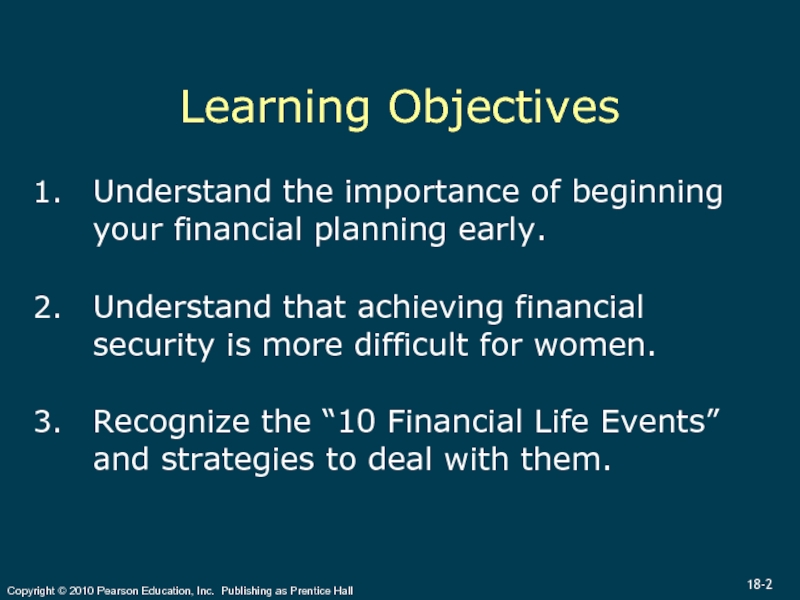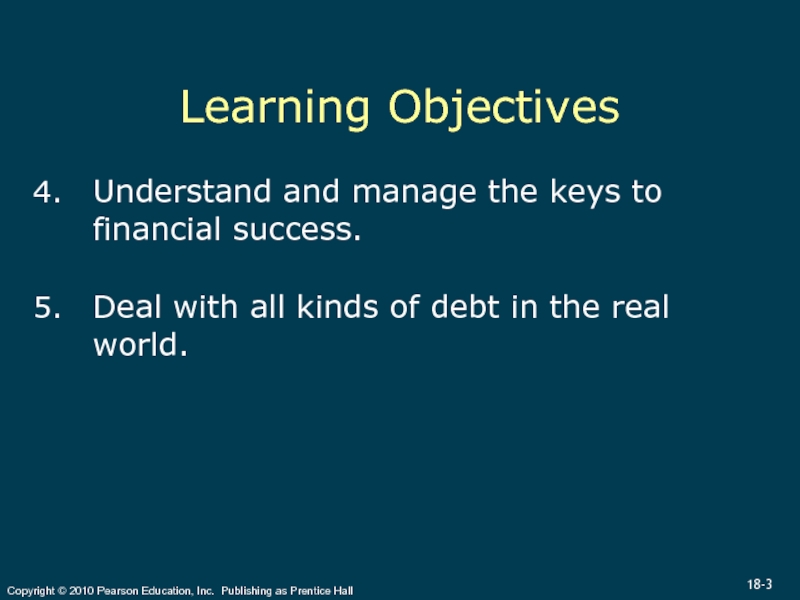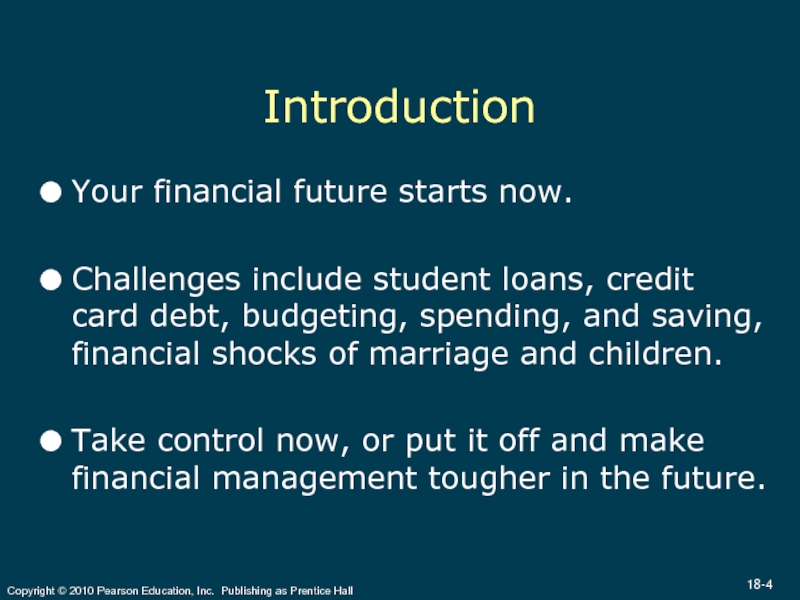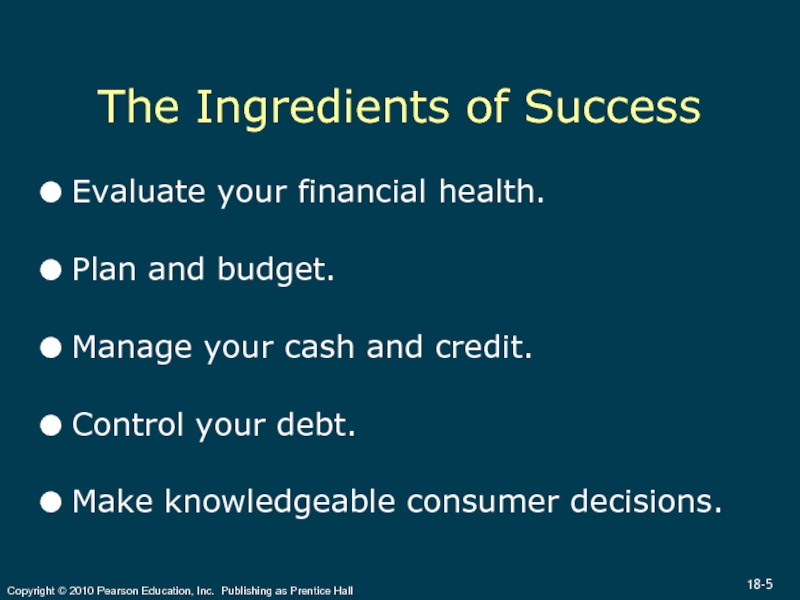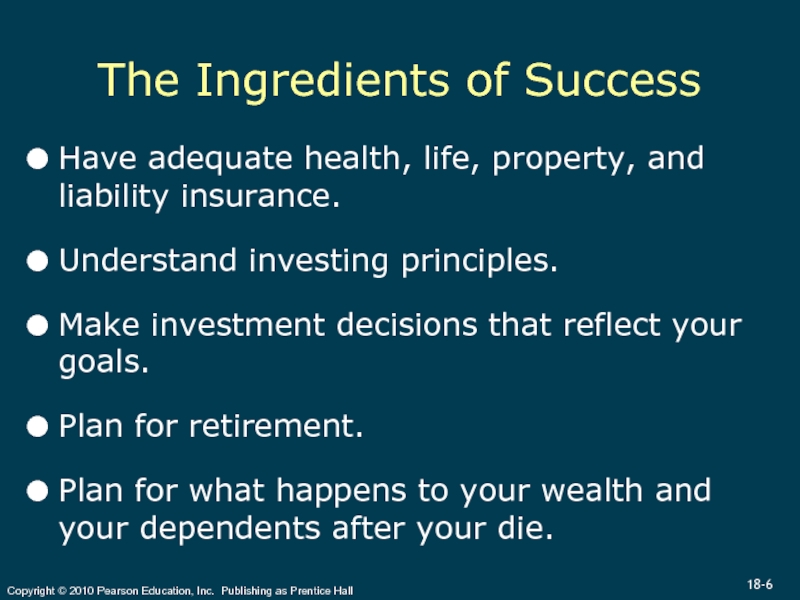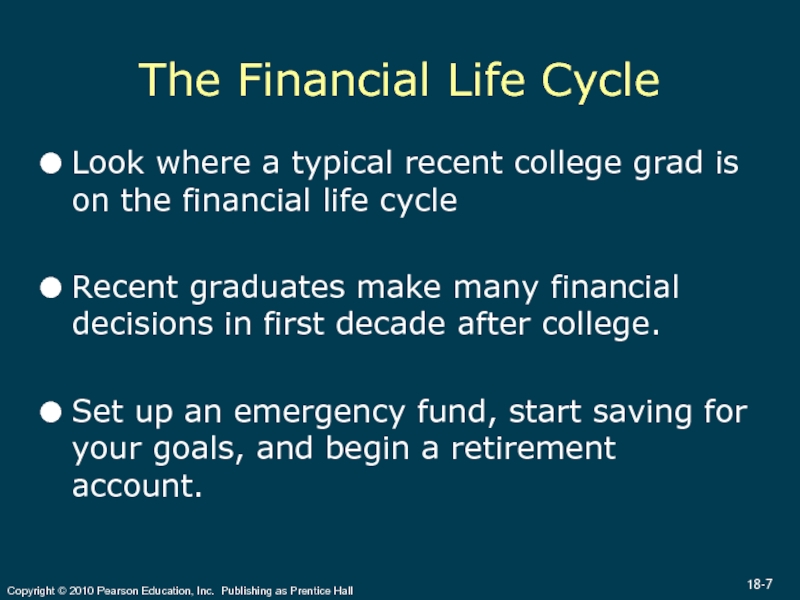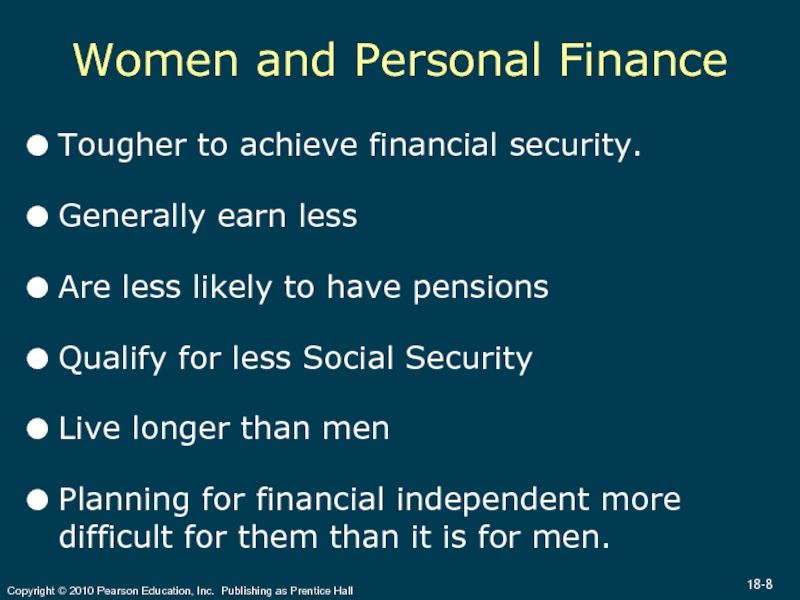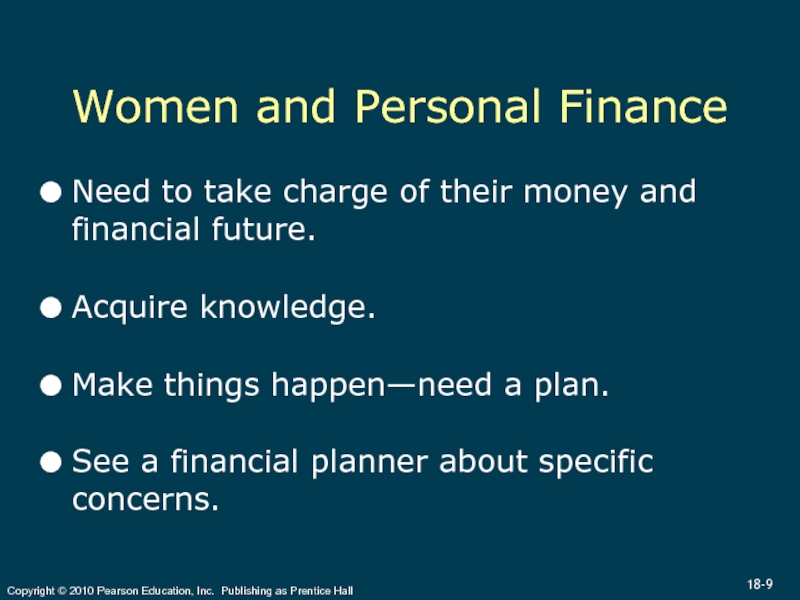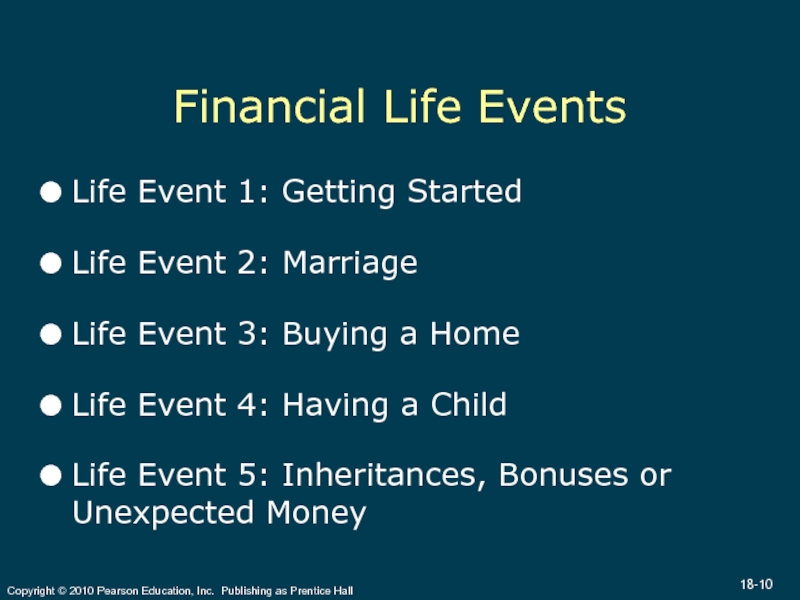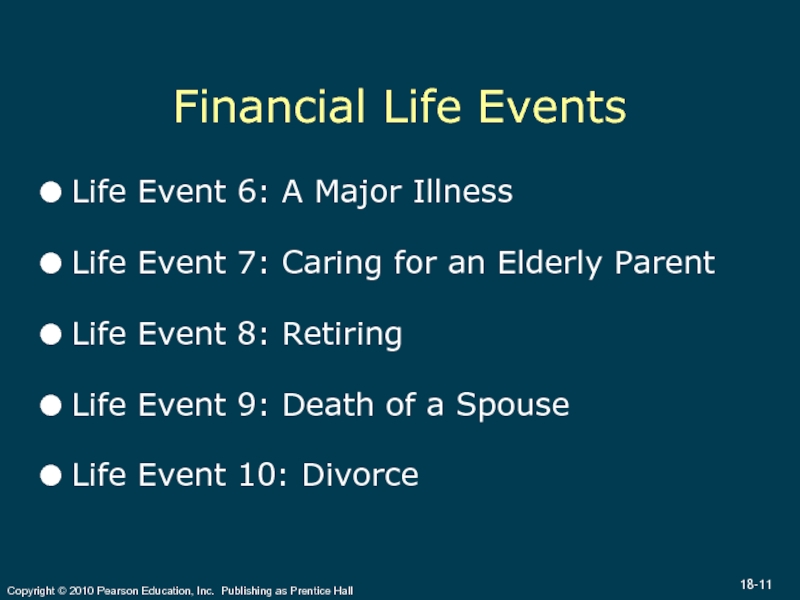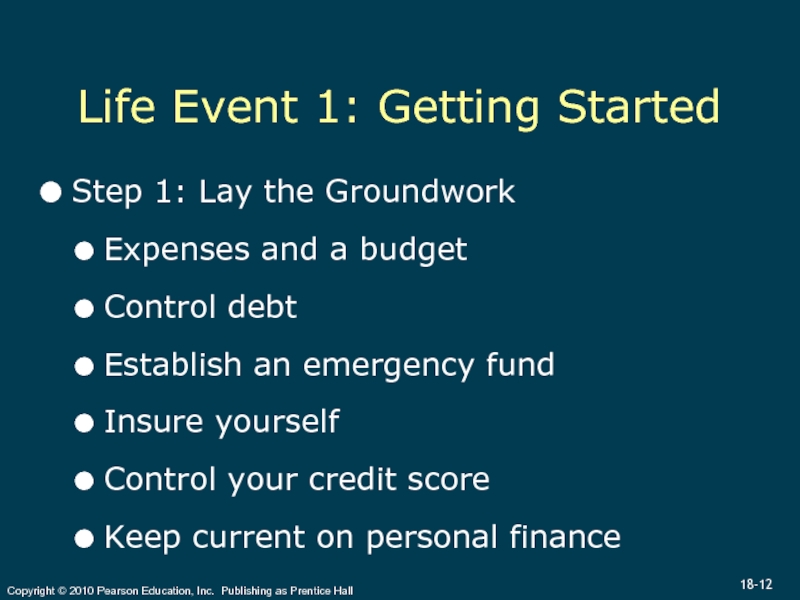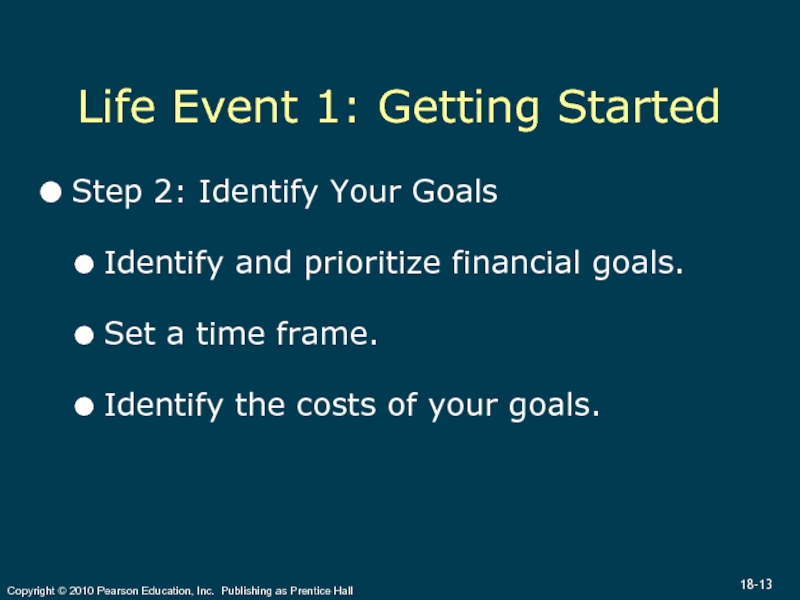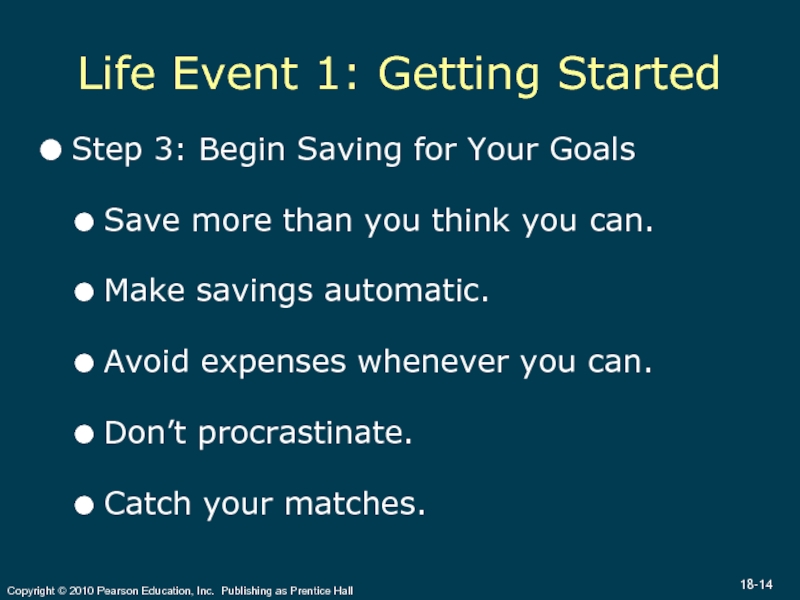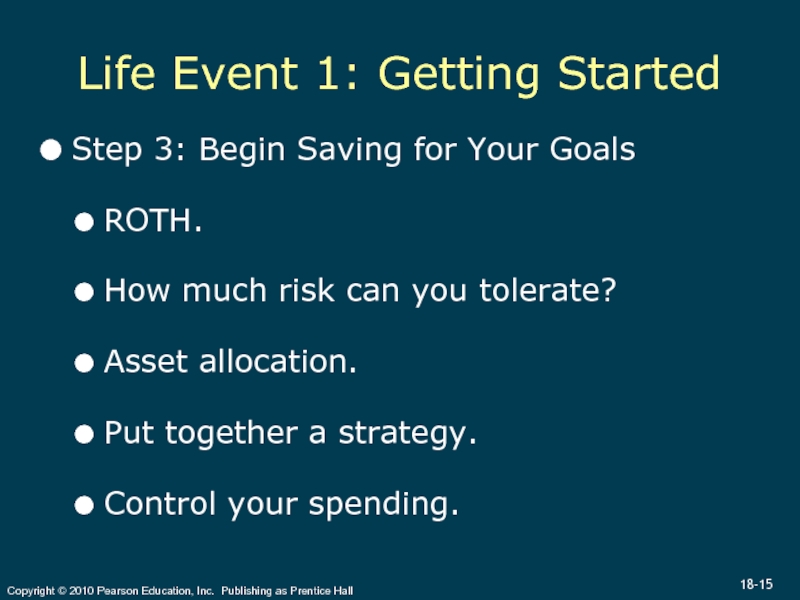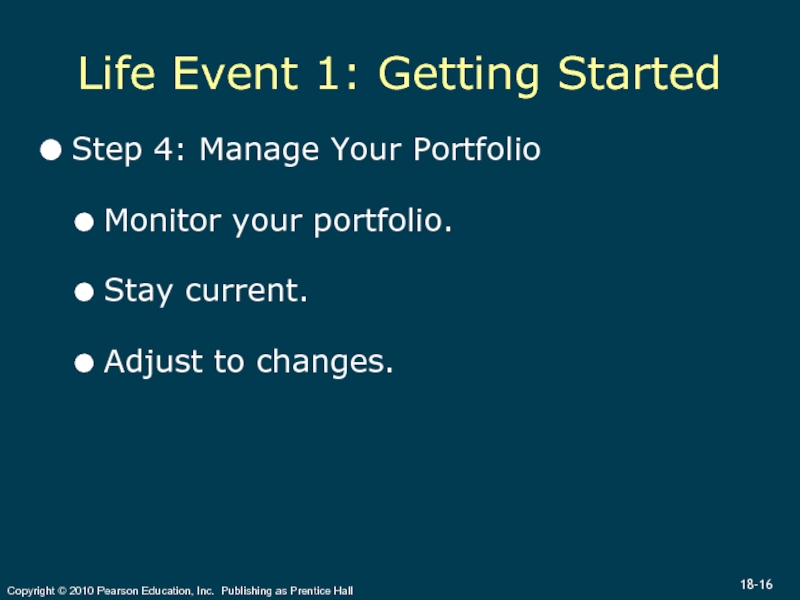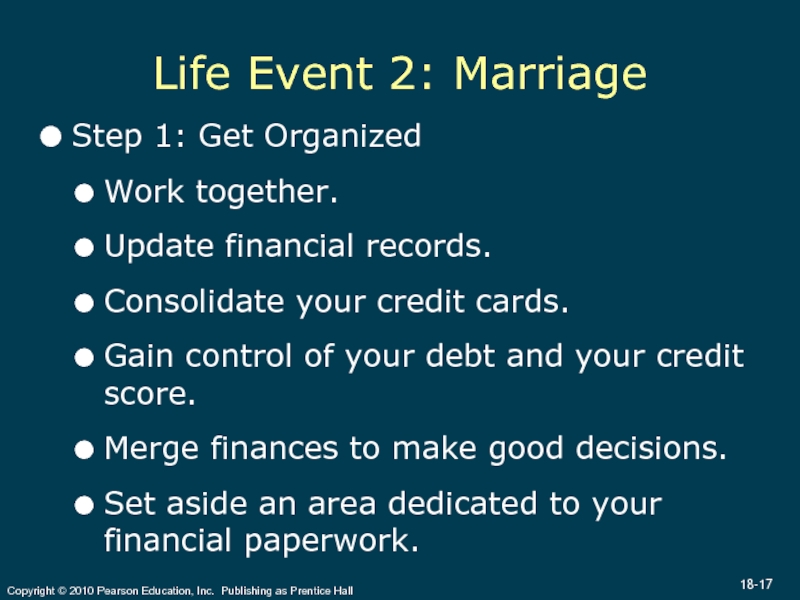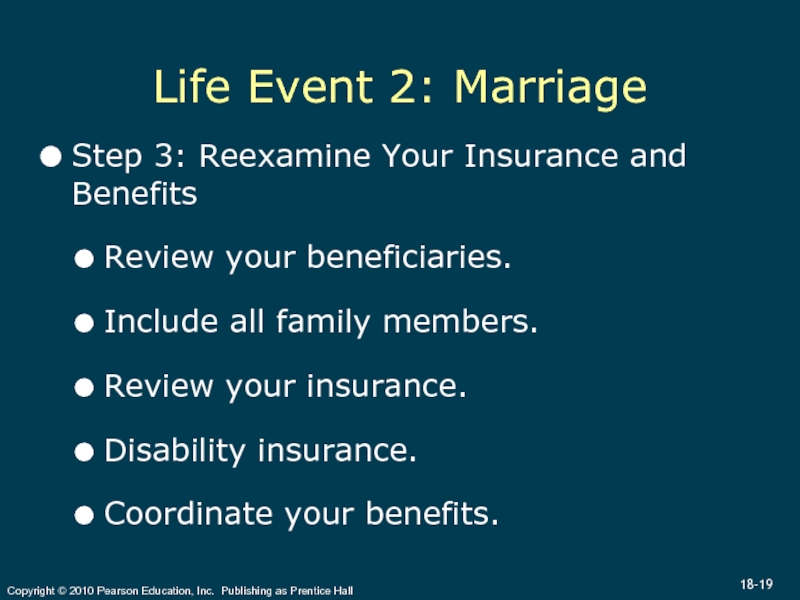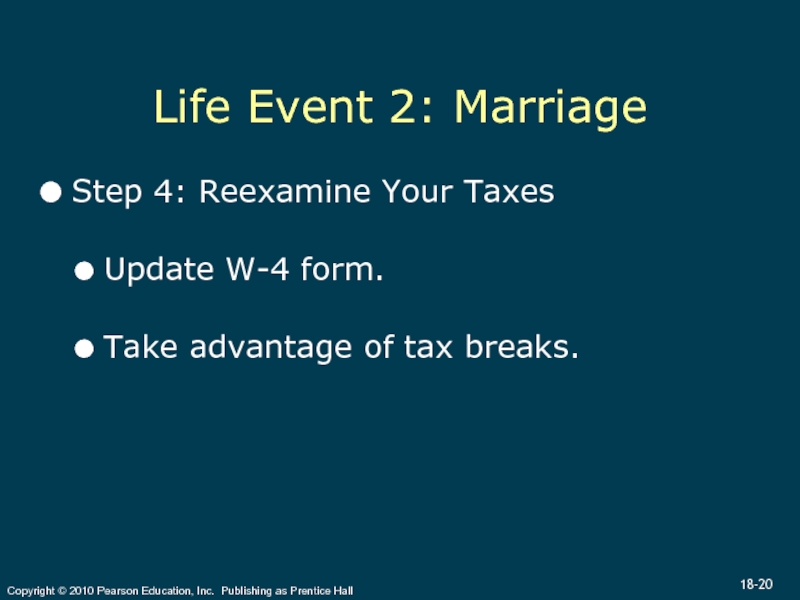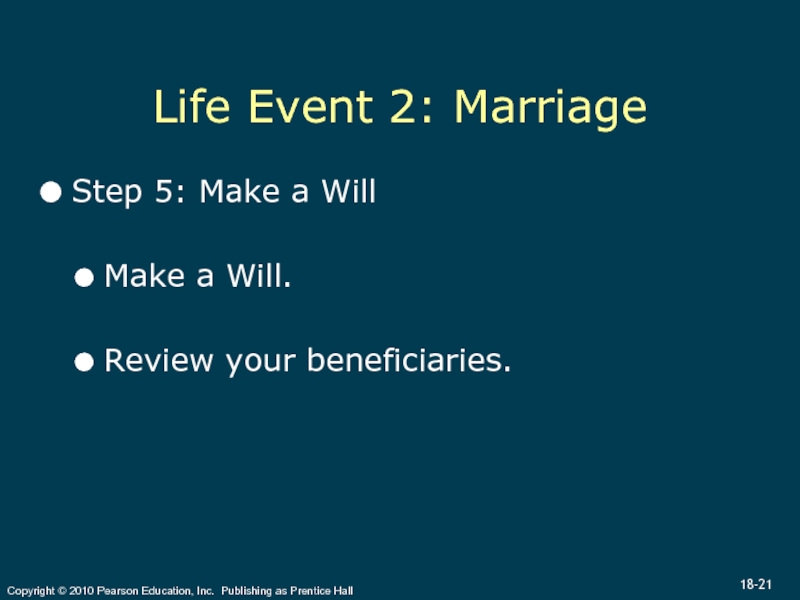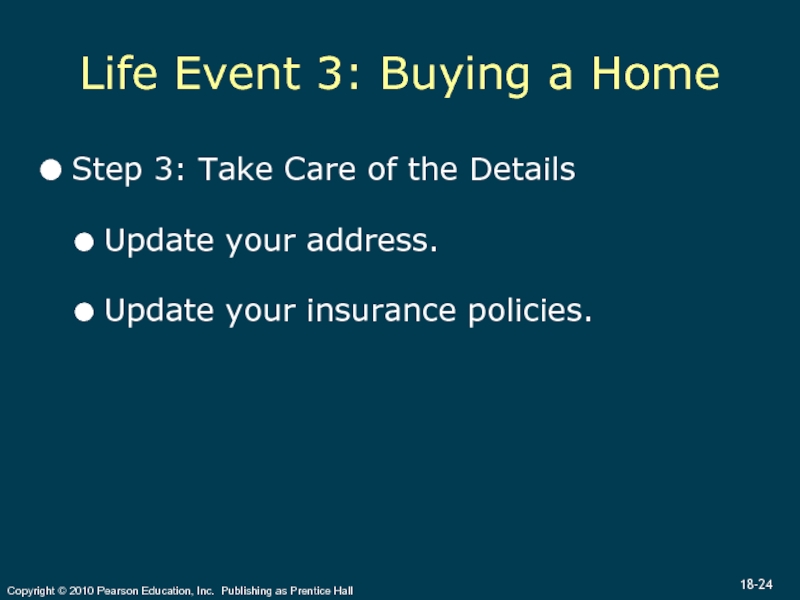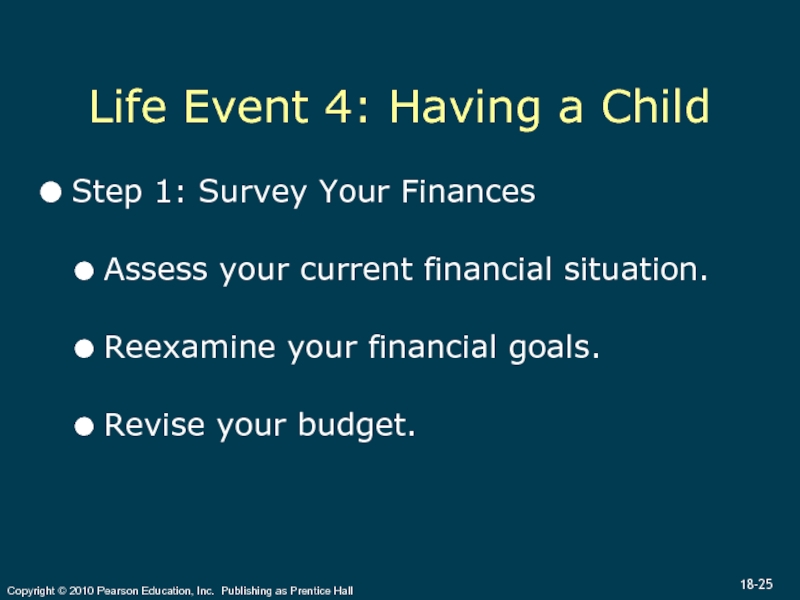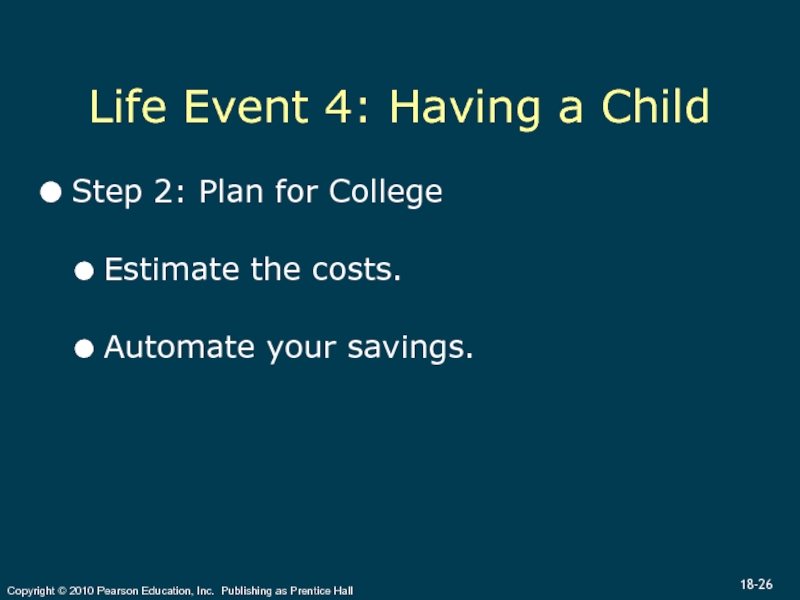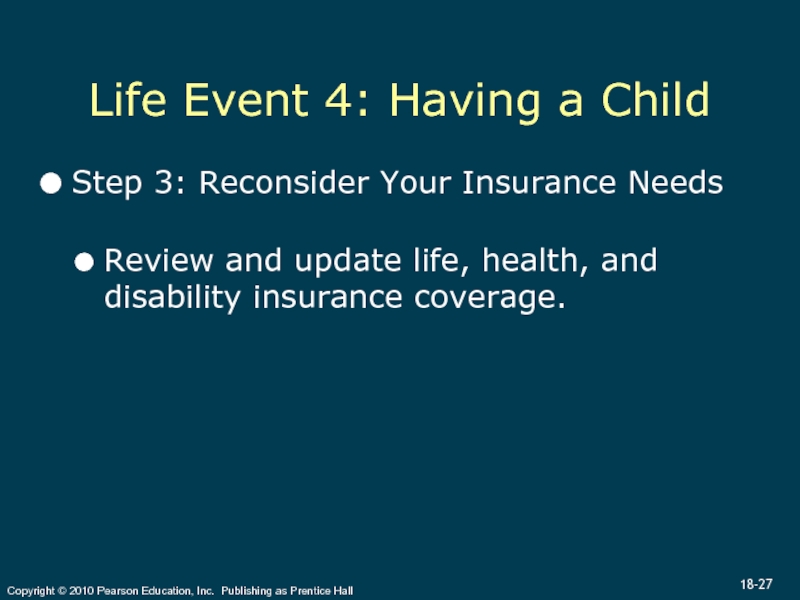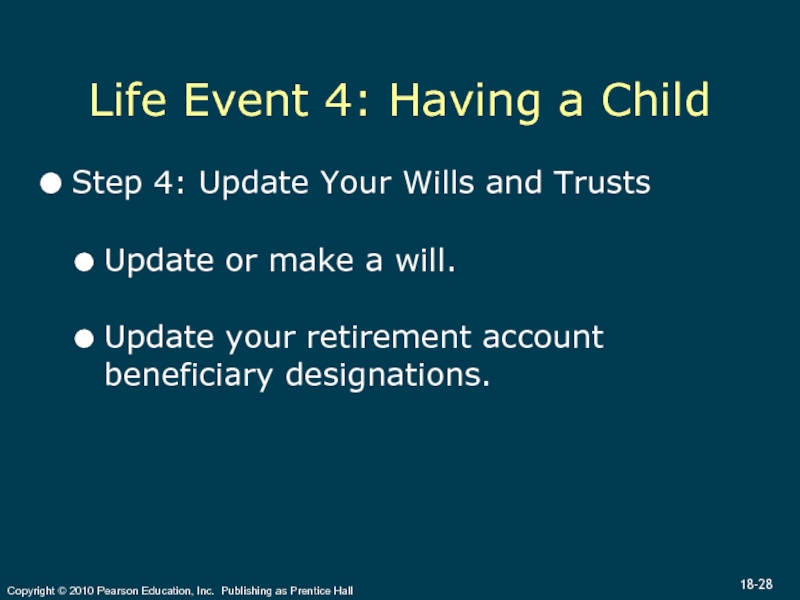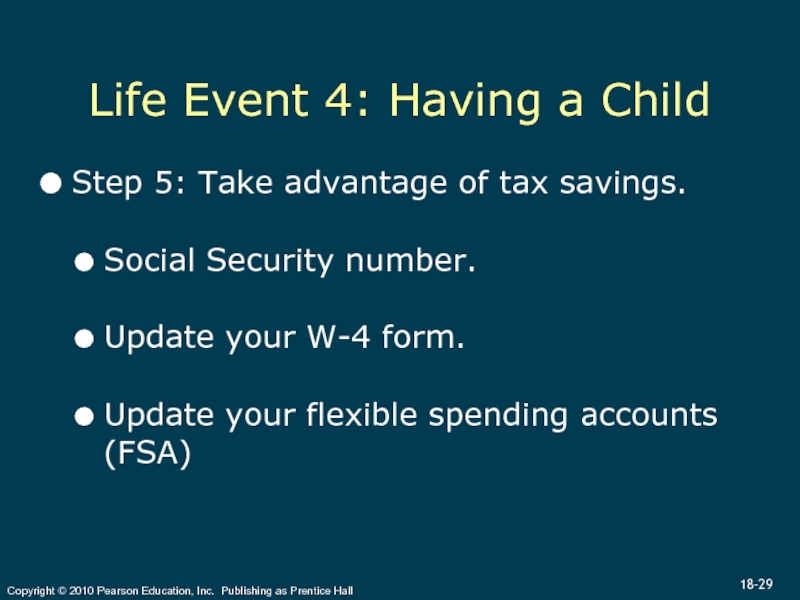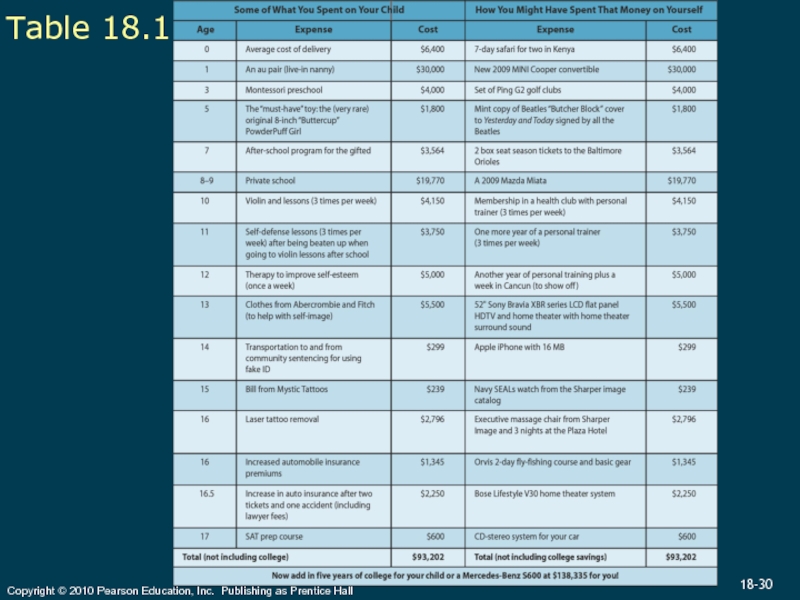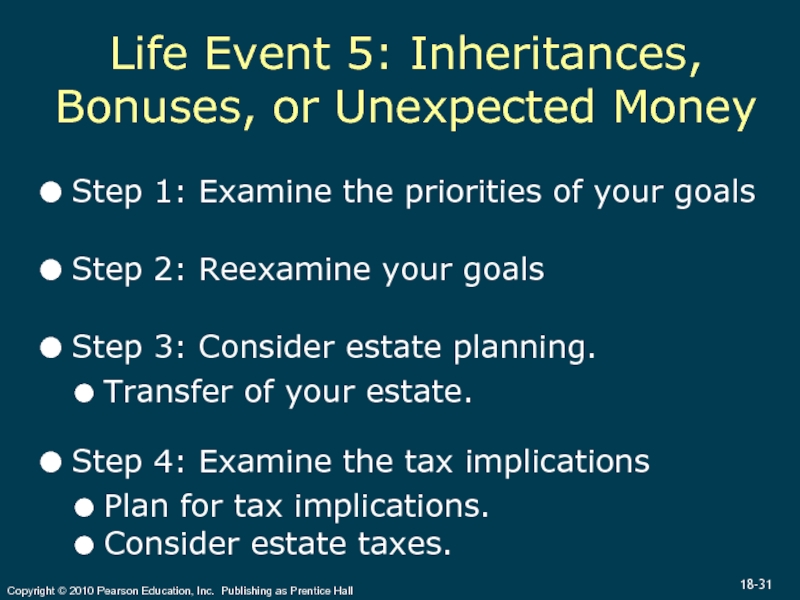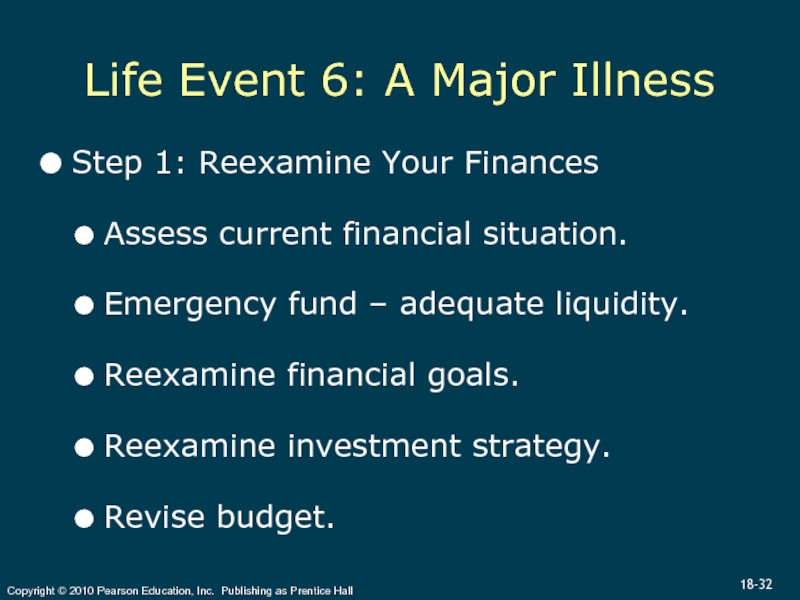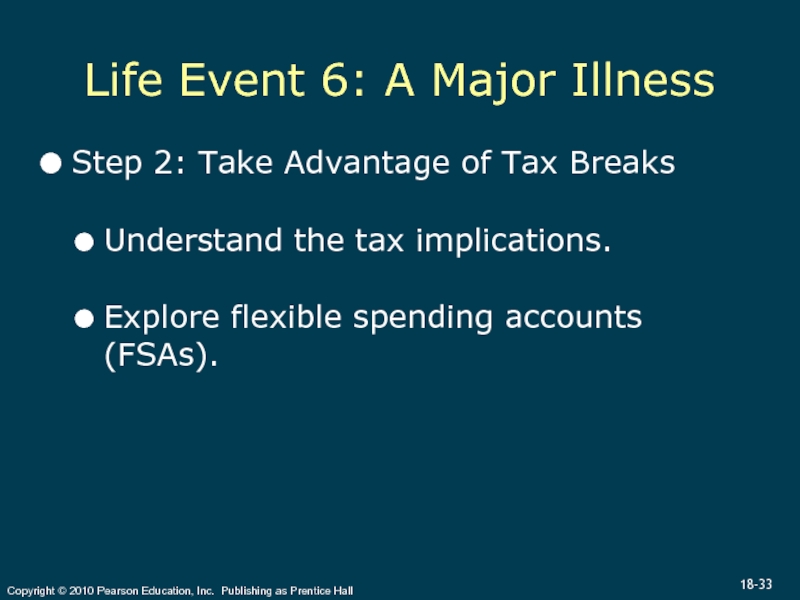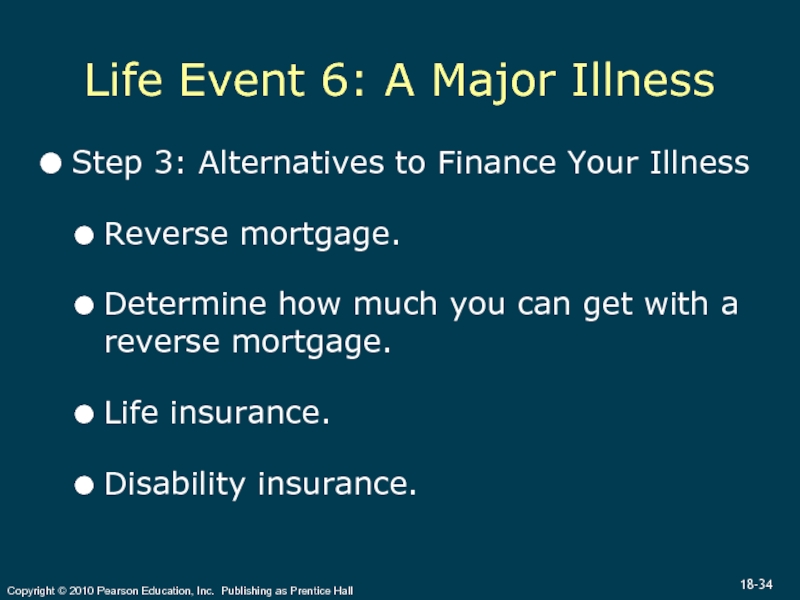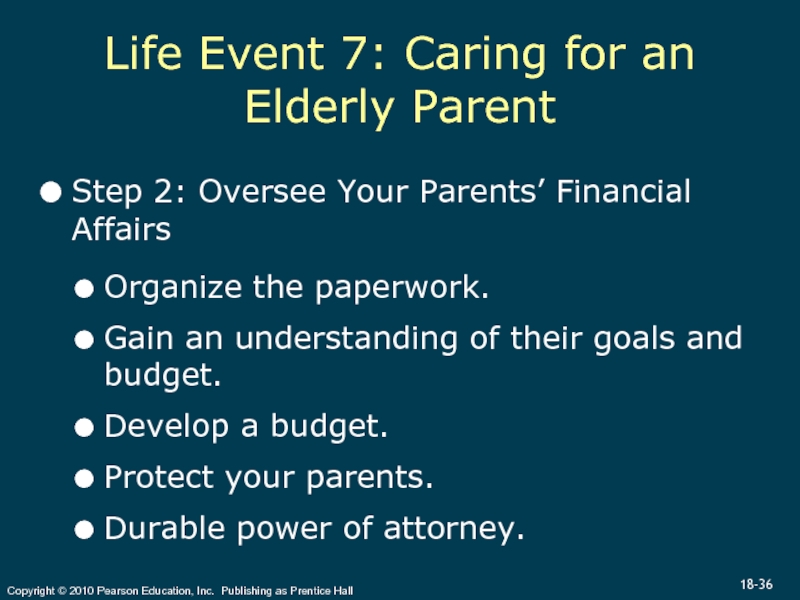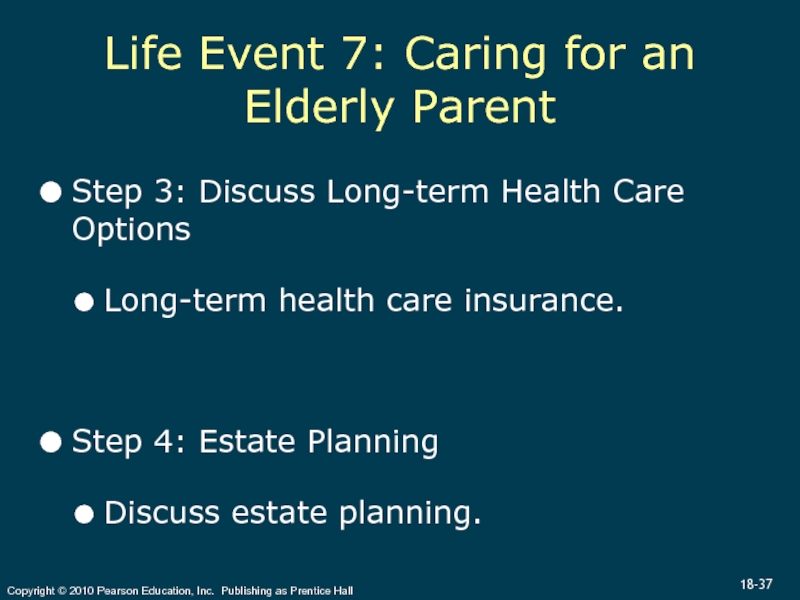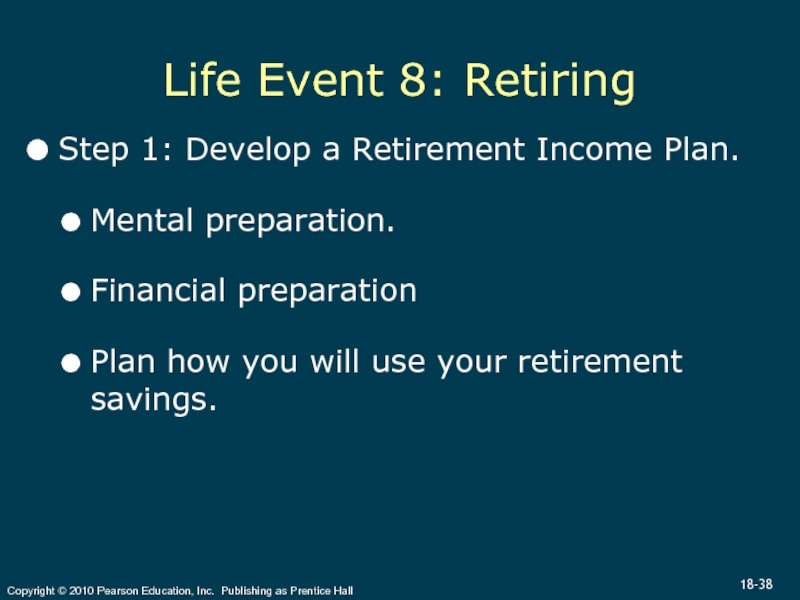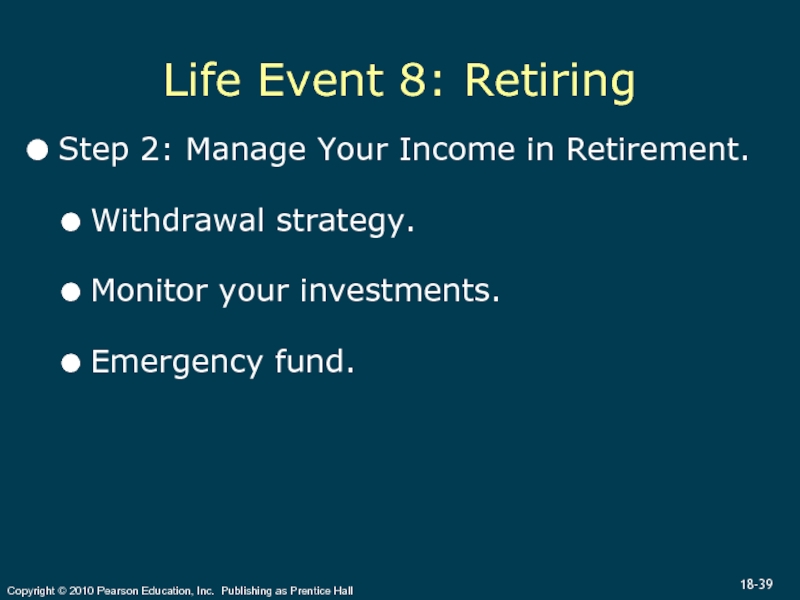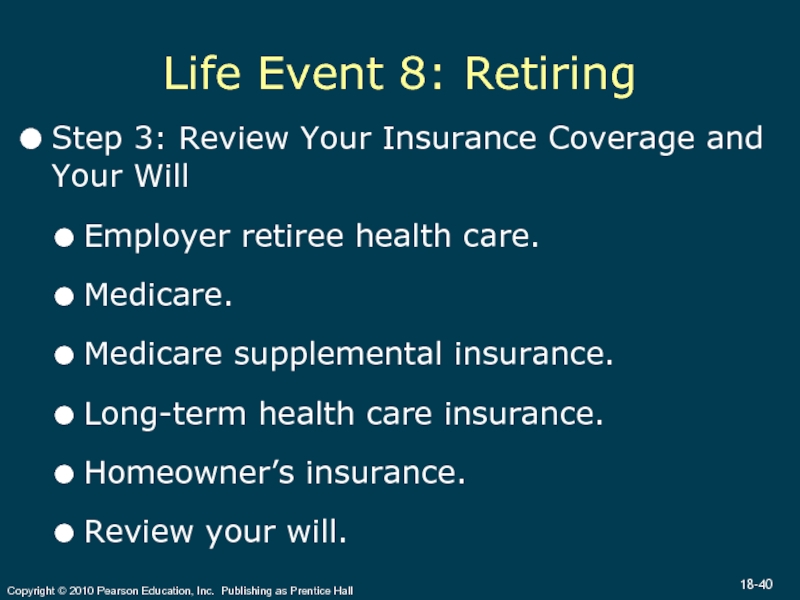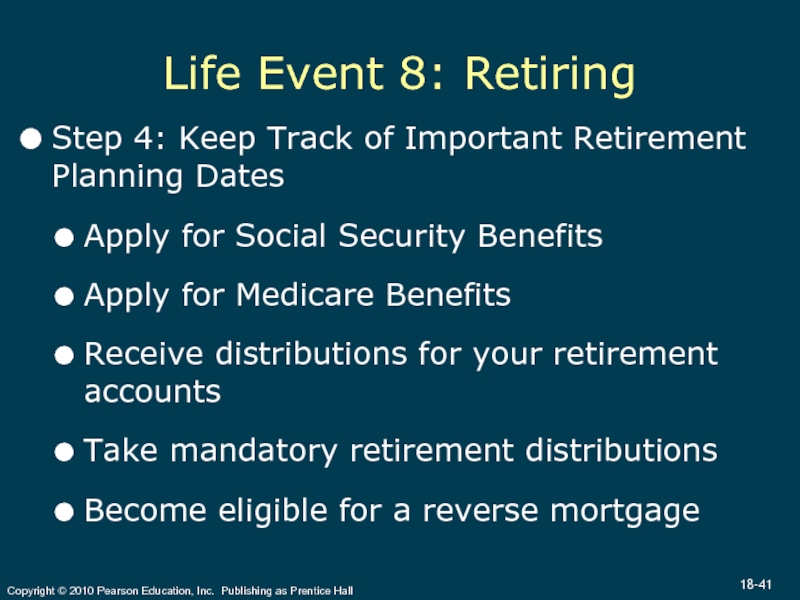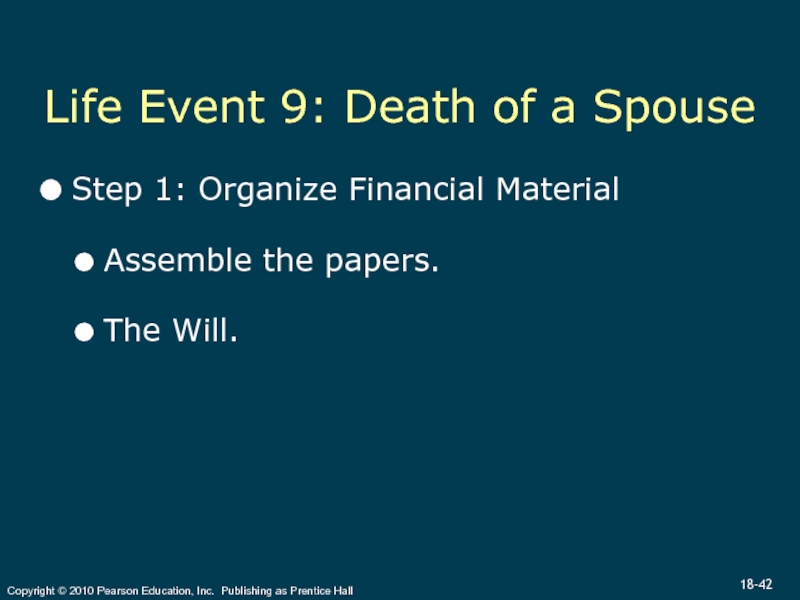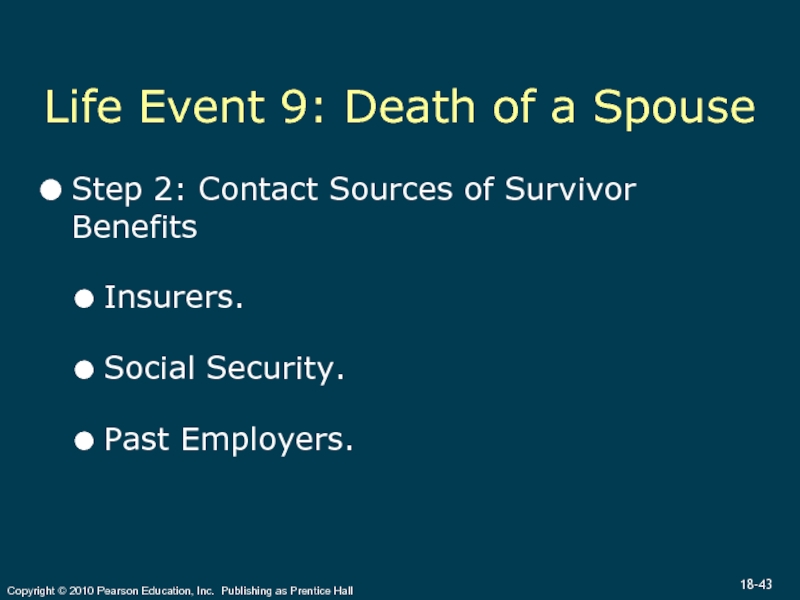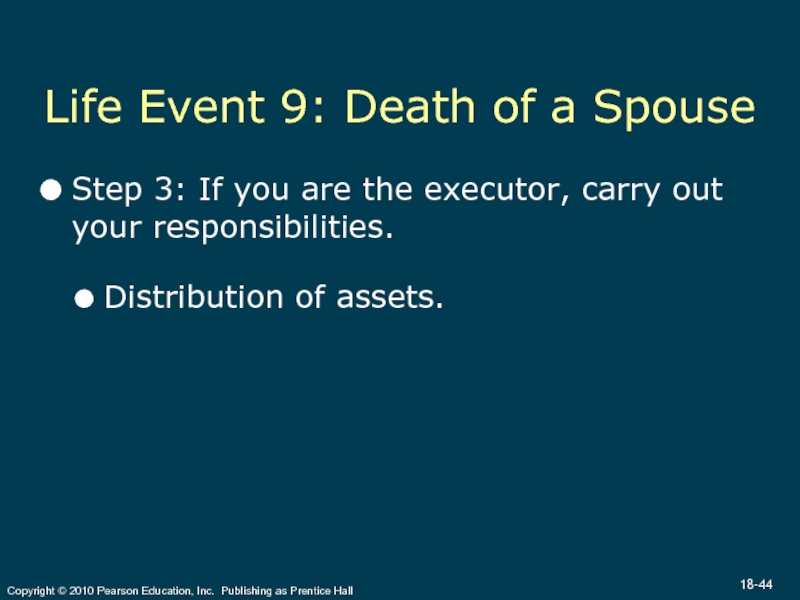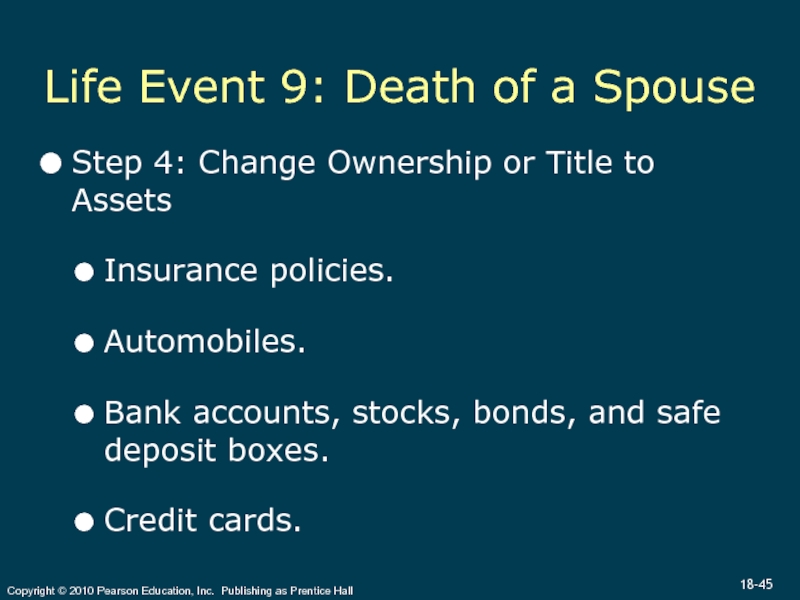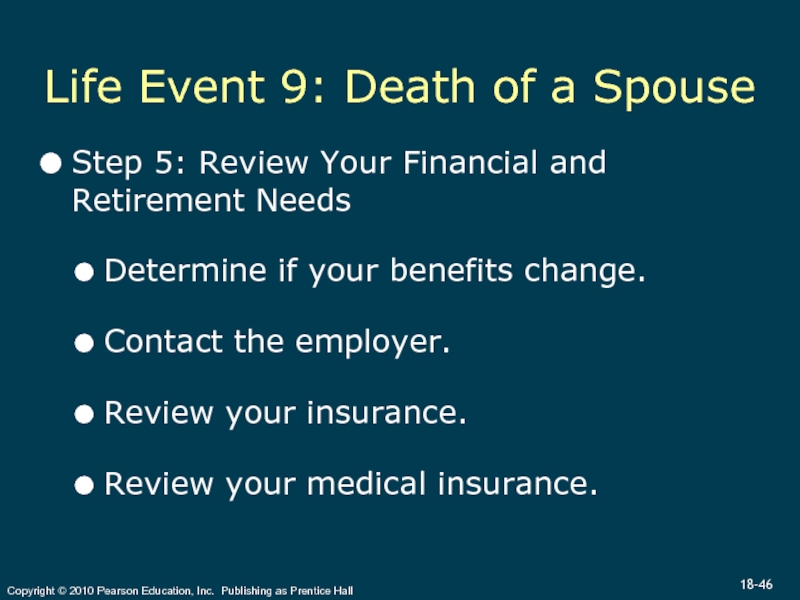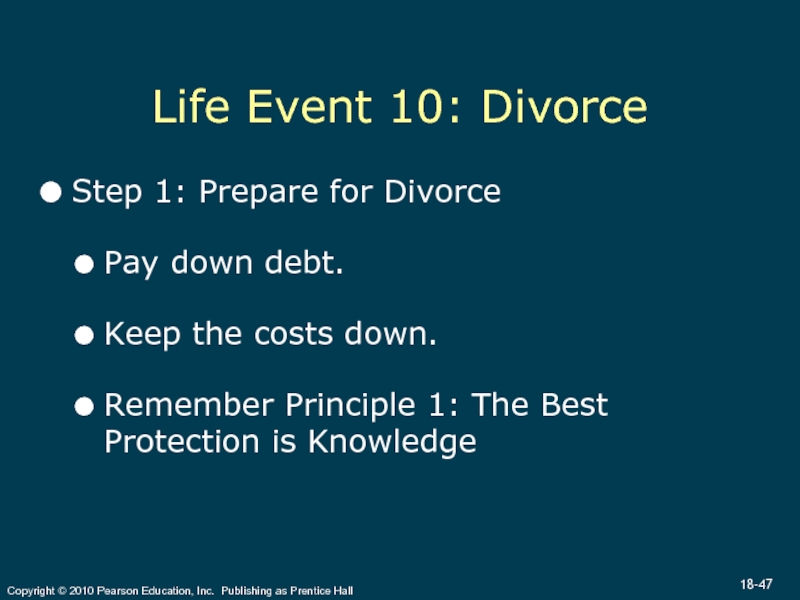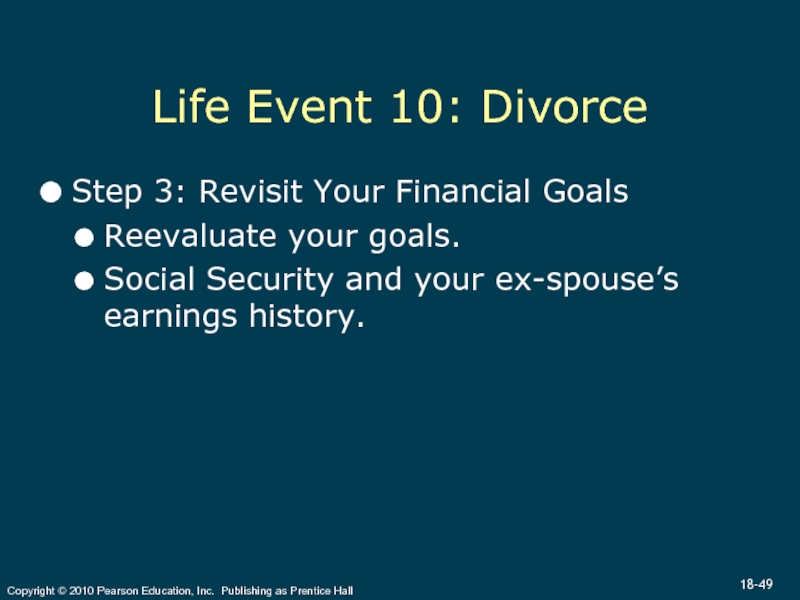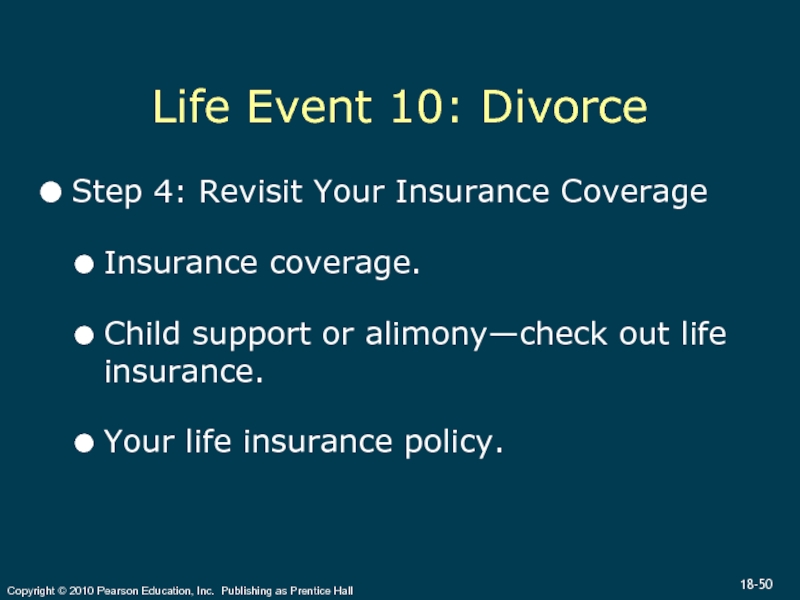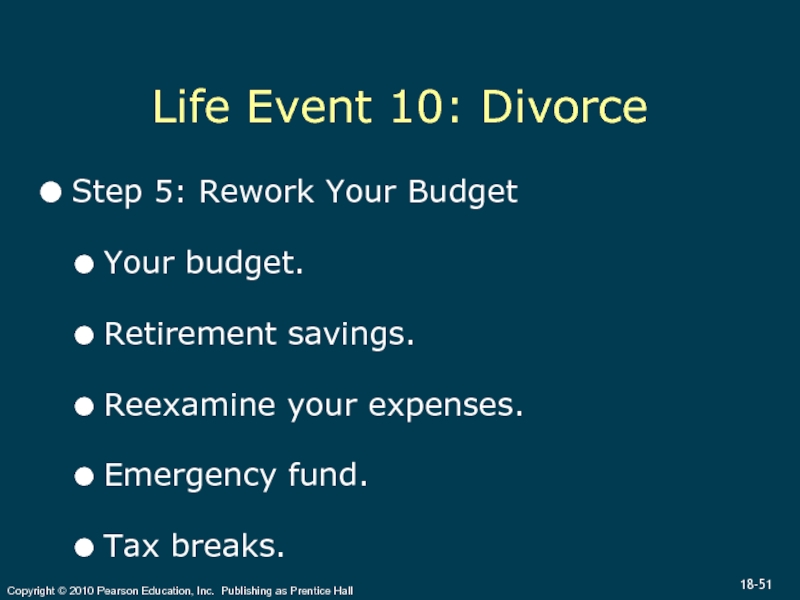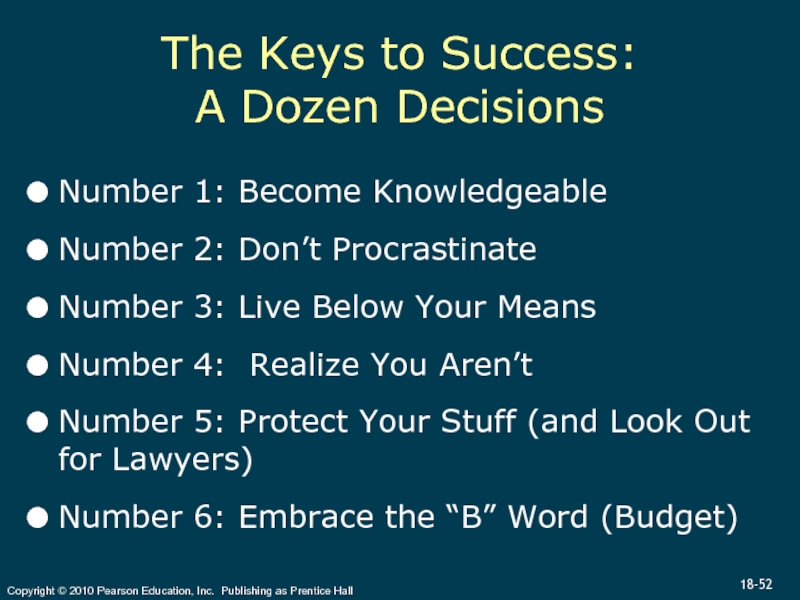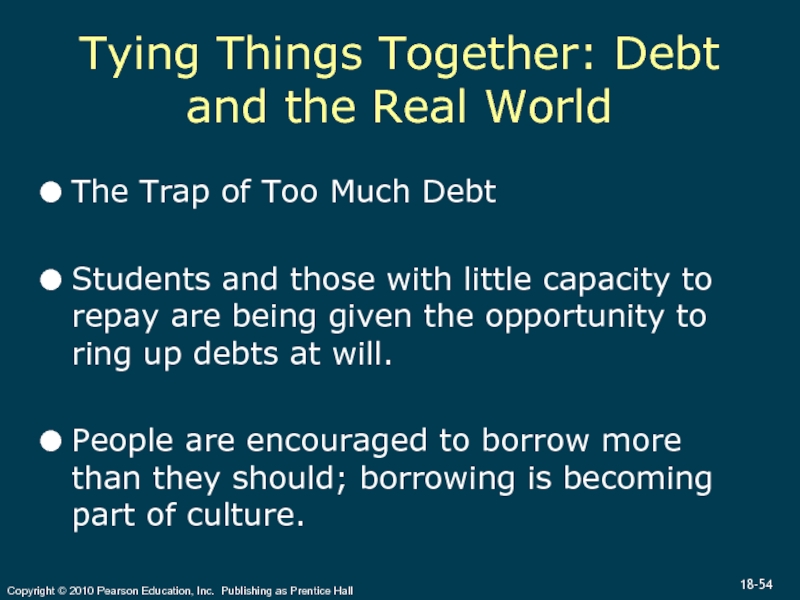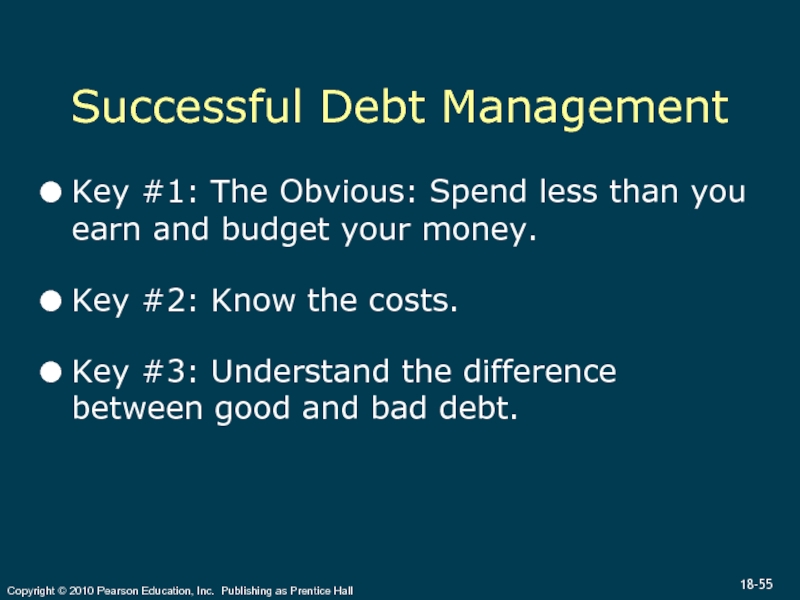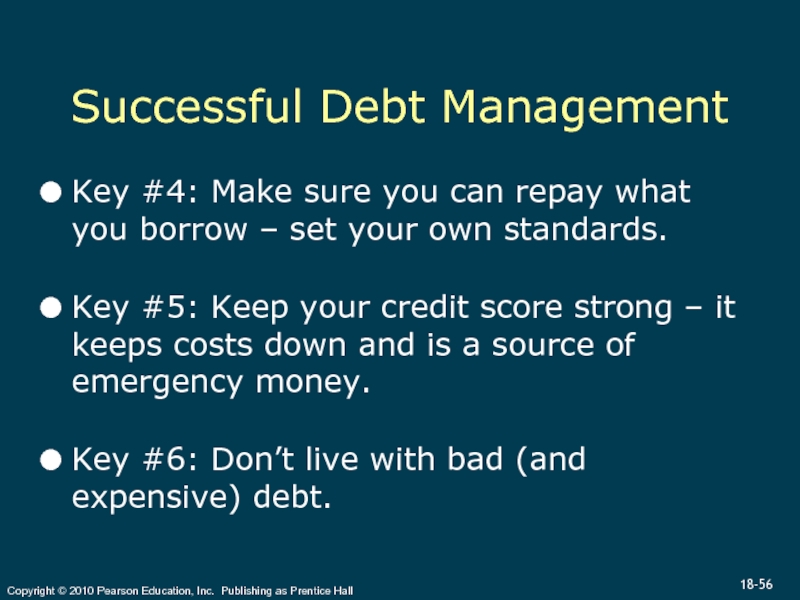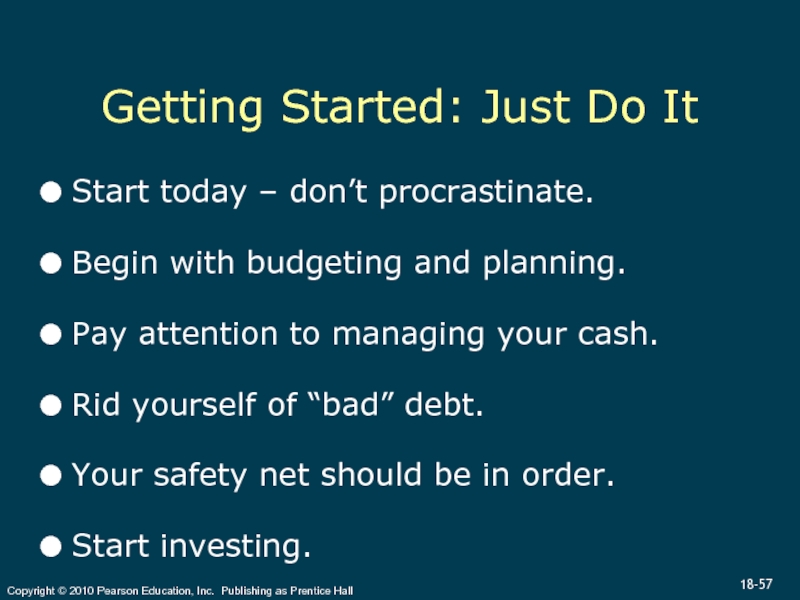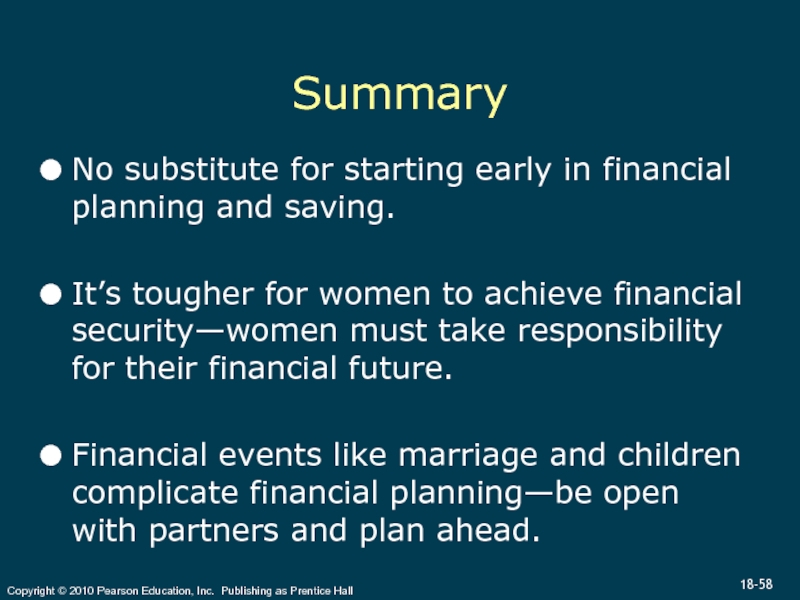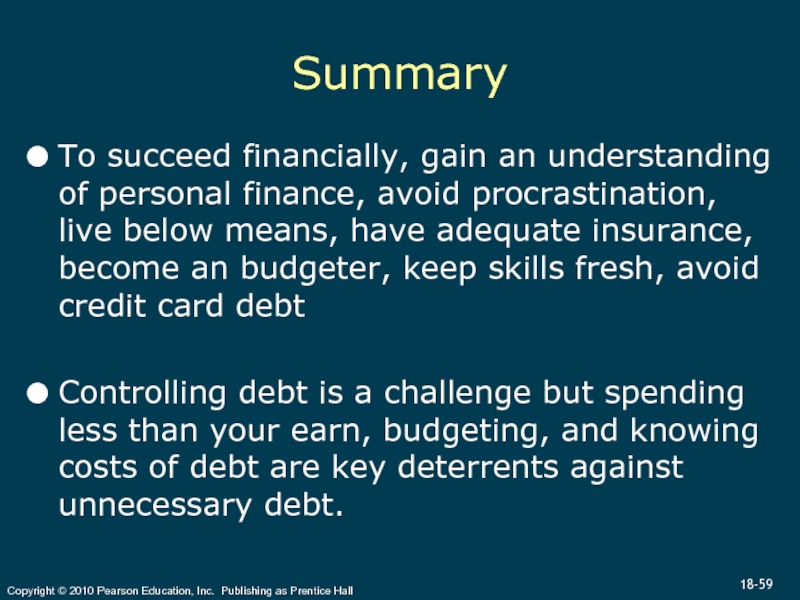Разделы презентаций
- Разное
- Английский язык
- Астрономия
- Алгебра
- Биология
- География
- Геометрия
- Детские презентации
- Информатика
- История
- Литература
- Математика
- Медицина
- Менеджмент
- Музыка
- МХК
- Немецкий язык
- ОБЖ
- Обществознание
- Окружающий мир
- Педагогика
- Русский язык
- Технология
- Физика
- Философия
- Химия
- Шаблоны, картинки для презентаций
- Экология
- Экономика
- Юриспруденция
Chapter 18
Содержание
- 1. Chapter 18
- 2. Learning ObjectivesUnderstand the importance of beginning your
- 3. Learning ObjectivesUnderstand and manage the keys to
- 4. Introduction Your financial future starts now.Challenges include
- 5. The Ingredients of SuccessEvaluate your financial health.Plan
- 6. The Ingredients of SuccessHave adequate health, life,
- 7. The Financial Life Cycle Look where a
- 8. Women and Personal FinanceTougher to achieve financial
- 9. Women and Personal FinanceNeed to take charge
- 10. Financial Life EventsLife Event 1: Getting StartedLife
- 11. Financial Life EventsLife Event 6: A Major
- 12. Life Event 1: Getting StartedStep 1: Lay
- 13. Life Event 1: Getting StartedStep 2: Identify
- 14. Life Event 1: Getting StartedStep 3: Begin
- 15. Life Event 1: Getting StartedStep 3: Begin
- 16. Life Event 1: Getting StartedStep 4: Manage Your PortfolioMonitor your portfolio.Stay current.Adjust to changes.
- 17. Life Event 2: MarriageStep 1: Get OrganizedWork
- 18. Life Event 2: MarriageStep 2: Revisit Your
- 19. Life Event 2: MarriageStep 3: Reexamine Your
- 20. Life Event 2: MarriageStep 4: Reexamine Your TaxesUpdate W-4 form.Take advantage of tax breaks.
- 21. Life Event 2: MarriageStep 5: Make a WillMake a Will.Review your beneficiaries.
- 22. Life Event 3: Buying a HomeStep 1:
- 23. Life Event 3: Buying a HomeStep 2:
- 24. Life Event 3: Buying a HomeStep 3:
- 25. Life Event 4: Having a ChildStep 1:
- 26. Life Event 4: Having a ChildStep 2: Plan for CollegeEstimate the costs.Automate your savings.
- 27. Life Event 4: Having a ChildStep 3:
- 28. Life Event 4: Having a ChildStep 4:
- 29. Life Event 4: Having a ChildStep 5:
- 30. Table 18.1
- 31. Life Event 5: Inheritances, Bonuses, or Unexpected
- 32. Life Event 6: A Major IllnessStep 1:
- 33. Life Event 6: A Major IllnessStep 2:
- 34. Life Event 6: A Major IllnessStep 3:
- 35. Life Event 7: Caring for an Elderly
- 36. Life Event 7: Caring for an Elderly
- 37. Life Event 7: Caring for an Elderly
- 38. Life Event 8: RetiringStep 1: Develop a
- 39. Life Event 8: RetiringStep 2: Manage Your Income in Retirement.Withdrawal strategy.Monitor your investments.Emergency fund.
- 40. Life Event 8: RetiringStep 3: Review Your
- 41. Life Event 8: RetiringStep 4: Keep Track
- 42. Life Event 9: Death of a SpouseStep 1: Organize Financial MaterialAssemble the papers.The Will.
- 43. Life Event 9: Death of a SpouseStep 2: Contact Sources of Survivor BenefitsInsurers.Social Security.Past Employers.
- 44. Life Event 9: Death of a SpouseStep
- 45. Life Event 9: Death of a SpouseStep
- 46. Life Event 9: Death of a SpouseStep
- 47. Life Event 10: DivorceStep 1: Prepare for
- 48. Life Event 10: DivorceStep 2: Avoid Credit
- 49. Life Event 10: DivorceStep 3: Revisit Your
- 50. Life Event 10: DivorceStep 4: Revisit Your
- 51. Life Event 10: DivorceStep 5: Rework Your BudgetYour budget.Retirement savings.Reexamine your expenses.Emergency fund.Tax breaks.
- 52. The Keys to Success: A Dozen
- 53. The Keys to Success: A Dozen DecisionsNumber
- 54. Tying Things Together: Debt and the Real
- 55. Successful Debt ManagementKey #1: The Obvious: Spend
- 56. Successful Debt ManagementKey #4: Make sure you
- 57. Getting Started: Just Do ItStart today –
- 58. Summary No substitute for starting early in
- 59. Summary To succeed financially, gain an understanding
- 60. Скачать презентанцию
Learning ObjectivesUnderstand the importance of beginning your financial planning early.Understand that achieving financial security is more difficult for women.Recognize the “10 Financial Life Events” and strategies to deal with them.
Слайды и текст этой презентации
Слайд 2Learning Objectives
Understand the importance of beginning your financial planning early.
Understand
that achieving financial security is more difficult for women.
“10 Financial Life Events” and strategies to deal with them.Слайд 3Learning Objectives
Understand and manage the keys to financial success.
Deal with
all kinds of debt in the real world.
Слайд 4Introduction
Your financial future starts now.
Challenges include student loans, credit
card debt, budgeting, spending, and saving, financial shocks of marriage
and children.Take control now, or put it off and make financial management tougher in the future.
Слайд 5The Ingredients of Success
Evaluate your financial health.
Plan and budget.
Manage your
cash and credit.
Control your debt.
Make knowledgeable consumer decisions.
Слайд 6The Ingredients of Success
Have adequate health, life, property, and liability
insurance.
Understand investing principles.
Make investment decisions that reflect your goals.
Plan for
retirement.Plan for what happens to your wealth and your dependents after your die.
Слайд 7The Financial Life Cycle
Look where a typical recent college
grad is on the financial life cycle
Recent graduates make many
financial decisions in first decade after college.Set up an emergency fund, start saving for your goals, and begin a retirement account.
Слайд 8Women and Personal Finance
Tougher to achieve financial security.
Generally earn
less
Are less likely to have pensions
Qualify for less Social
SecurityLive longer than men
Planning for financial independent more difficult for them than it is for men.
Слайд 9Women and Personal Finance
Need to take charge of their money
and financial future.
Acquire knowledge.
Make things happen—need a plan.
See a financial
planner about specific concerns.Слайд 10Financial Life Events
Life Event 1: Getting Started
Life Event 2: Marriage
Life
Event 3: Buying a Home
Life Event 4: Having a Child
Life
Event 5: Inheritances, Bonuses or Unexpected MoneyСлайд 11Financial Life Events
Life Event 6: A Major Illness
Life Event 7:
Caring for an Elderly Parent
Life Event 8: Retiring
Life Event 9:
Death of a SpouseLife Event 10: Divorce
Слайд 12Life Event 1: Getting Started
Step 1: Lay the Groundwork
Expenses and
a budget
Control debt
Establish an emergency fund
Insure yourself
Control your credit score
Keep
current on personal financeСлайд 13Life Event 1: Getting Started
Step 2: Identify Your Goals
Identify and
prioritize financial goals.
Set a time frame.
Identify the costs of your
goals.Слайд 14Life Event 1: Getting Started
Step 3: Begin Saving for Your
Goals
Save more than you think you can.
Make savings automatic.
Avoid expenses
whenever you can.Don’t procrastinate.
Catch your matches.
Слайд 15Life Event 1: Getting Started
Step 3: Begin Saving for Your
Goals
ROTH.
How much risk can you tolerate?
Asset allocation.
Put together a strategy.
Control
your spending.Слайд 16Life Event 1: Getting Started
Step 4: Manage Your Portfolio
Monitor your
portfolio.
Stay current.
Adjust to changes.
Слайд 17Life Event 2: Marriage
Step 1: Get Organized
Work together.
Update financial records.
Consolidate
your credit cards.
Gain control of your debt and your credit
score.Merge finances to make good decisions.
Set aside an area dedicated to your financial paperwork.
Слайд 18Life Event 2: Marriage
Step 2: Revisit Your Financial Goals
Reexamine your
financial goals.
Begin saving for new goals.
Make your saving automatic.
Make sure
you have an emergency fund.Begin working towards retirement.
Слайд 19Life Event 2: Marriage
Step 3: Reexamine Your Insurance and Benefits
Review
your beneficiaries.
Include all family members.
Review your insurance.
Disability insurance.
Coordinate your
benefits.Слайд 20Life Event 2: Marriage
Step 4: Reexamine Your Taxes
Update W-4 form.
Take
advantage of tax breaks.
Слайд 22Life Event 3: Buying a Home
Step 1: The purchase fit
your financial plan
Keep track of your credit score.
Слайд 23Life Event 3: Buying a Home
Step 2: Consider Tax Implications
Take
advantage of the tax benefits.
Build the tax benefits into your
budget.Reexamine your investments.
Update your employer records.
Know your state.
Слайд 24Life Event 3: Buying a Home
Step 3: Take Care of
the Details
Update your address.
Update your insurance policies.
Слайд 25Life Event 4: Having a Child
Step 1: Survey Your Finances
Assess
your current financial situation.
Reexamine your financial goals.
Revise your budget.
Слайд 26Life Event 4: Having a Child
Step 2: Plan for College
Estimate
the costs.
Automate your savings.
Слайд 27Life Event 4: Having a Child
Step 3: Reconsider Your Insurance
Needs
Review and update life, health, and disability insurance coverage.
Слайд 28Life Event 4: Having a Child
Step 4: Update Your Wills
and Trusts
Update or make a will.
Update your retirement account beneficiary
designations.Слайд 29Life Event 4: Having a Child
Step 5: Take advantage of
tax savings.
Social Security number.
Update your W-4 form.
Update your flexible spending
accounts (FSA)Слайд 31Life Event 5: Inheritances, Bonuses, or Unexpected Money
Step 1: Examine
the priorities of your goals
Step 2: Reexamine your goals
Step 3:
Consider estate planning.Transfer of your estate.
Step 4: Examine the tax implications
Plan for tax implications.
Consider estate taxes.
Слайд 32Life Event 6: A Major Illness
Step 1: Reexamine Your Finances
Assess
current financial situation.
Emergency fund – adequate liquidity.
Reexamine financial goals.
Reexamine investment
strategy.Revise budget.
Слайд 33Life Event 6: A Major Illness
Step 2: Take Advantage of
Tax Breaks
Understand the tax implications.
Explore flexible spending accounts (FSAs).
Слайд 34Life Event 6: A Major Illness
Step 3: Alternatives to Finance
Your Illness
Reverse mortgage.
Determine how much you can get with a
reverse mortgage.Life insurance.
Disability insurance.
Слайд 35Life Event 7: Caring for an Elderly Parent
Step 1: Health
Care and Estate Planning Concerns
Initiate a dialogue with your parents.
Слайд 36Life Event 7: Caring for an Elderly Parent
Step 2: Oversee
Your Parents’ Financial Affairs
Organize the paperwork.
Gain an understanding of their
goals and budget.Develop a budget.
Protect your parents.
Durable power of attorney.
Слайд 37Life Event 7: Caring for an Elderly Parent
Step 3: Discuss
Long-term Health Care Options
Long-term health care insurance.
Step 4: Estate Planning
Discuss
estate planning. Слайд 38Life Event 8: Retiring
Step 1: Develop a Retirement Income Plan.
Mental
preparation.
Financial preparation
Plan how you will use your retirement savings.
Слайд 39Life Event 8: Retiring
Step 2: Manage Your Income in Retirement.
Withdrawal
strategy.
Monitor your investments.
Emergency fund.
Слайд 40Life Event 8: Retiring
Step 3: Review Your Insurance Coverage and
Your Will
Employer retiree health care.
Medicare.
Medicare supplemental insurance.
Long-term health care insurance.
Homeowner’s
insurance.Review your will.
Слайд 41Life Event 8: Retiring
Step 4: Keep Track of Important Retirement
Planning Dates
Apply for Social Security Benefits
Apply for Medicare Benefits
Receive distributions
for your retirement accountsTake mandatory retirement distributions
Become eligible for a reverse mortgage
Слайд 42Life Event 9: Death of a Spouse
Step 1: Organize Financial
Material
Assemble the papers.
The Will.
Слайд 43Life Event 9: Death of a Spouse
Step 2: Contact Sources
of Survivor Benefits
Insurers.
Social Security.
Past Employers.
Слайд 44Life Event 9: Death of a Spouse
Step 3: If you
are the executor, carry out your responsibilities.
Distribution of assets.
Слайд 45Life Event 9: Death of a Spouse
Step 4: Change Ownership
or Title to Assets
Insurance policies.
Automobiles.
Bank accounts, stocks, bonds, and safe
deposit boxes.Credit cards.
Слайд 46Life Event 9: Death of a Spouse
Step 5: Review Your
Financial and Retirement Needs
Determine if your benefits change.
Contact the employer.
Review
your insurance.Review your medical insurance.
Слайд 47Life Event 10: Divorce
Step 1: Prepare for Divorce
Pay down debt.
Keep
the costs down.
Remember Principle 1: The Best Protection is Knowledge
Слайд 48Life Event 10: Divorce
Step 2: Avoid Credit Damage
Joint accounts.
Late
payments and your credit report.
Late payments? Have your account “re-aged.”
Слайд 49Life Event 10: Divorce
Step 3: Revisit Your Financial Goals
Reevaluate your
goals.
Social Security and your ex-spouse’s earnings history.
Слайд 50Life Event 10: Divorce
Step 4: Revisit Your Insurance Coverage
Insurance coverage.
Child
support or alimony—check out life insurance.
Your life insurance policy.
Слайд 51Life Event 10: Divorce
Step 5: Rework Your Budget
Your budget.
Retirement savings.
Reexamine
your expenses.
Emergency fund.
Tax breaks.
Слайд 52The Keys to Success:
A Dozen Decisions
Number 1: Become Knowledgeable
Number
2: Don’t Procrastinate
Number 3: Live Below Your Means
Number 4: Realize
You Aren’tNumber 5: Protect Your Stuff (and Look Out for Lawyers)
Number 6: Embrace the “B” Word (Budget)
Слайд 53The Keys to Success:
A Dozen Decisions
Number 7: Reinvent and Upgrade
Your Skills
Number 8: Hide Your Plastic
Number 9: Stocks Are Risky,
But Not as Risky as Not Investing in ThemNumber 10: Exploit Tax-Favored Retirement Plans to the Fullest.
Number 11: Plan for the Number of Children You Want.
Number 12: Stay Married.
Слайд 54Tying Things Together: Debt and the Real World
The Trap of
Too Much Debt
Students and those with little capacity to repay
are being given the opportunity to ring up debts at will.People are encouraged to borrow more than they should; borrowing is becoming part of culture.
Слайд 55Successful Debt Management
Key #1: The Obvious: Spend less than you
earn and budget your money.
Key #2: Know the costs.
Key #3:
Understand the difference between good and bad debt.Слайд 56Successful Debt Management
Key #4: Make sure you can repay what
you borrow – set your own standards.
Key #5: Keep
your credit score strong – it keeps costs down and is a source of emergency money.Key #6: Don’t live with bad (and expensive) debt.
Слайд 57Getting Started: Just Do It
Start today – don’t procrastinate.
Begin with
budgeting and planning.
Pay attention to managing your cash.
Rid yourself of
“bad” debt.Your safety net should be in order.
Start investing.
Слайд 58Summary
No substitute for starting early in financial planning and
saving.
It’s tougher for women to achieve financial security—women must take
responsibility for their financial future.Financial events like marriage and children complicate financial planning—be open with partners and plan ahead.
Слайд 59Summary
To succeed financially, gain an understanding of personal finance,
avoid procrastination, live below means, have adequate insurance, become an
budgeter, keep skills fresh, avoid credit card debtControlling debt is a challenge but spending less than your earn, budgeting, and knowing costs of debt are key deterrents against unnecessary debt.

